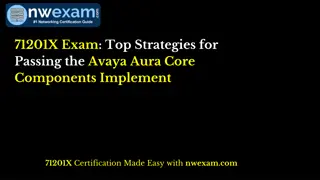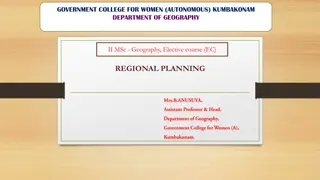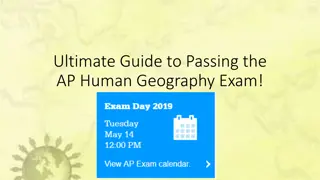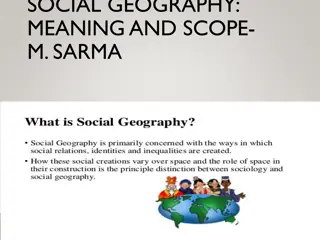Geography Practice Exam Round 1 Questions
Practice your AP Human Geography knowledge with these multiple-choice questions covering topics such as demographic indicators, cultural diffusion, population growth, cultural landscapes, and urban land use patterns. Test your understanding of concepts like fertility rates, diffusion types, population clustering, demographic transitions, cultural differences, and urban land values. Enhance your geographical knowledge and prepare for exams by answering these thought-provoking questions.
Download Presentation

Please find below an Image/Link to download the presentation.
The content on the website is provided AS IS for your information and personal use only. It may not be sold, licensed, or shared on other websites without obtaining consent from the author.If you encounter any issues during the download, it is possible that the publisher has removed the file from their server.
You are allowed to download the files provided on this website for personal or commercial use, subject to the condition that they are used lawfully. All files are the property of their respective owners.
The content on the website is provided AS IS for your information and personal use only. It may not be sold, licensed, or shared on other websites without obtaining consent from the author.
E N D
Presentation Transcript
APHG PRACTICE EXAM ROUND 1
1. The term describing the average number of births a woman will bear in her lifetime is Crude birth rate A. Crude death rate B. Total fertility rate C. Natural increase rate D.
2. New trends in clothing styles might originate in big cities like Paris, London, or New York. Then, they might spread to smaller cities like Las Vegas, Dallas, or Denver. From there, they spread to smaller towns. This would be an example of what type of diffusion? Contagious diffusion A. Expansion diffusion B. Hierarchical diffusion C. Relocation diffusion D.
3. African Americans are clustered in the ________ part of the United States, while Asian Americans are clustered in the ________ part of the United States. (Make sure to select the choice with the answers in the correct order.) Western, Northeastern A. Western, Southeastern B. Southeastern, Northeastern C. Southeastern, Western D.
4. The worlds population in 1985 was approximately 5 billion people. With a consistent rate of growth, the total population was expected to reach 10 billion in about 35 years - year 2020. The period of 35 years is known as Demographic transition rate A. Life expectancy B. Natural increase rate C. Doubling time D.
5. Which of the following is TRUE about the difference between folk culture and popular culture? Popular culture is usually practiced by a relatively small group of people A. Popular culture is usually practiced by people living in isolation from other groups B. Folk culture is usually practiced by homogenous groups C. Folk culture is usually practiced by a relatively large group of people D.
6. According to the classic bid-rent curve, what happens to the value of land as one gets closer to the Central Business District (CBD)? Land gets used more extensively. A. Land gets more expensive. B. Land gets used less intensively. C. Land gets more affordable along busy streets. D.
7. The visible imprint put on the environment by people is called? Cultural Landscape A. Place B. Location C. Human Environment Interaction D.
8. What does it mean when a religion does not seek converts and is usually spatially concentrated? Universal A. Global B. Animist C. Ethnic D.
9. Whip/nae nae, Harlem Shake, or Ice bucket challenge videos are examples this type of diffusion... Relocation Diffusion A. Contagious Diffusion B. Stimulus Diffusion C. Hierarchical Diffusion D.
10. Which of the following religions would be a good example of a hierarchical religion? Buddhism (Buddhists) A. LDS Religion (Mormons) B. Hinduism (Hindus) C. Islam (Muslims) D.
11. The annual global population growth rate increased approximately two hundred years ago because of the Green Revolution A. Agricultural Revolution B. Industrial Revolution C. Medical Revolution D.
12. The result of overgrazing in semi-arid climates is environmental modification A. desertification B. aquaculture C. desalination D.
13. According to Carl Sauer, there are two distinctive types of agriculture vegetative planting and double-cropping A. shifting cultivation and vegetative planting B. vegetative planting and seed agriculture C. slash-and-burn agriculture and double-cropping D.
14. Which crop is associated with intensive agriculture? Corn A. Rice B. Wheat C. Cotton D.
15. Mediterranean agriculture must be practiced in a climate that is Several different crops produced in the same year A. Plentiful rainfall year round B. Dry summer, cool moist winter C. Mild and dry year round D.
16. All of the following are true about the Green Revolution EXCEPT Several different crops produced in the same year A. Only tested on farms in MDCs B. Allows for plants and animals that grow in conditions they normally would not C. Led to the increase in industrial farming D.
17. Which of the following includes the worlds earliest centers of plant domestication? Northeast Asia, Eastern Europe, South Africa A. Russia, China, Latin America B. British Isles, Scandinavia, United States C. Southeast Asia, Mesoamerica, Middle East D.
18. Physiological density is defined as the average farm production compared to arable land. A. the number of farmers as compared to the total population. B. the number of people compared to arable land. C. the number of farms compared to the total land area. D.
19. Into which stage of the demographic transition model would Australia and Canada fit? 1 A. 2 B. 3 C. 4 D.
20. Farmers that produce food that they need to survive on a daily basis are called Commercial agriculture A. Industrial agriculture B. Slash-and-burn agriculture C. subsistence agriculture D.
APHG REVIEW ROUND 1
1. The term describing the average number of births a woman will bear in her lifetime is Crude birth rate A. Crude death rate B. Total fertility rate C. Natural increase rate D.
2. New trends in clothing styles might originate in big cities like Paris, London, or New York. Then, they might spread to smaller cities like Las Vegas, Dallas, or Denver. From there, they spread to smaller towns. This would be an example of what type of diffusion? Contagious diffusion A. Expansion diffusion B. Hierarchical diffusion C. Relocation diffusion D.
3. African Americans are clustered in the ________ part of the United States, while Asian Americans are clustered in the ________ part of the United States. (Make sure to select the choice with the answers in the correct order.) Western, Northeastern A. Western, Southeastern B. Southeastern, Northeastern C. Southeastern, Western D.
4. The worlds population in 1985 was approximately 5 billion people. With a consistent rate of growth, the total population was expected to reach 10 billion in about 35 years - year 2020. The period of 35 years is known as Demographic transition rate A. Life expectancy B. Natural increase rate C. Doubling time D.
5. Which of the following is TRUE about the difference between folk culture and popular culture? Popular culture is usually practiced by a relatively small group of people A. Popular culture is usually practiced by people living in isolation from other groups B. Folk culture is usually practiced by homogenous groups C. Folk culture is usually practiced by a relatively large group of people D.
6. According to the classic bid-rent curve, what happens to the value of land as one gets closer to the Central Business District (CBD)? Land gets used more extensively. A. Land gets more expensive. B. Land gets used less intensively. C. Land gets more affordable along busy streets. D.
7. The visible imprint put on the environment by people is called? Cultural Landscape A. Place B. Location C. Human Environment Interaction D.
8. What does it mean when a religion does not seek converts and is usually spatially concentrated? Universal A. Global B. Animist C. Ethnic D.
9. Whip/nae nae, Harlem Shake, or Ice bucket challenge videos are examples this type of diffusion... Relocation Diffusion A. Contagious Diffusion B. Stimulus Diffusion C. Hierarchical Diffusion D.
10. Which of the following religions would be a good example of a hierarchical religion? Buddhism (Buddhists) A. LDS Religion (Mormons) B. Hinduism (Hindus) C. Islam (Muslims) D.
11. The annual global population growth rate increased approximately two hundred years ago because of the Green Revolution A. Agricultural Revolution B. Industrial Revolution C. Medical Revolution D.
12. The result of overgrazing in semi-arid climates is environmental modification A. desertification B. aquaculture C. desalination D.
13. According to Carl Sauer, there are two distinctive types of agriculture vegetative planting and double-cropping A. shifting cultivation and vegetative planting B. vegetative planting and seed agriculture C. slash-and-burn agriculture and double-cropping D.
14. Which crop is associated with intensive agriculture? Corn A. Rice B. Wheat C. Cotton D.
15. Mediterranean agriculture must be practiced in a climate that is Several different crops produced in the same year A. Plentiful rainfall year round B. Dry summer, cool moist winter C. Mild and dry year round D.
16. All of the following are true about the Green Revolution EXCEPT Several different crops produced in the same year A. Only tested on farms in MDCs B. Allows for plants and animals that grow in conditions they normally would not C. Led to the increase in industrial farming D.
17. Which of the following includes the worlds earliest centers of plant domestication? Northeast Asia, Eastern Europe, South Africa A. Russia, China, Latin America B. British Isles, Scandinavia, United States C. Southeast Asia, Mesoamerica, Middle East D.
18. Physiological density is defined as the average farm production compared to arable land. A. the number of farmers as compared to the total population. B. the number of people compared to arable land. C. the number of farms compared to the total land area. D.
19. Into which stage of the demographic transition model would Australia and Canada fit? 1 A. 2 B. 3 C. 4 D.
20. Farmers that produce food that they need to survive on a daily basis are called Commercial agriculture A. Industrial agriculture B. Slash-and-burn agriculture C. subsistence agriculture D.
APHG PRACTICE EXAM ROUND 2
21. Which type of agriculture is found primarily in developing countries? Several different crops produced in the same year A. Truck farming B. Mediterranean C. Livestock ranching D.
22. Which of the following definitions best matches the term "assimilation?" The process of a less dominant culture losing their culture to a more dominant one. A. When a language develops distinct variations in pronunciation and vocabulary, based on geographic regions. B. The development of an increasingly integrated global economy. C. The adoption of cultural traits by one group when it comes into contact with another cultural group. D.
23. Which of the following examples would Juan Carlos consider as a "push factor," as he considers moving from his home country of Mexico to Canada? Harsh climates and weather conditions in Canada A. A federally funded health care system in Canada B. A large majority of people practice his religion (Catholocism) in his home country C. High crime rates and drug problems in his hometown of Mexico D.
24. According to von Thunen's Model, which agricultural zone is closest to the market? Livestock A. Commercial Grain B. Dairy Farming C. Forestry D.
25. All of the following are assumptions made in the von Thunen model EXCEPT Terrain has forested areas with several small lakes and rivers A. Farmers sell all of their harvest B. The city is located centrally within an isolated state C. Soil and climate are the same D.
26. According to Ravensteins Laws of Migration, every migration flow generatesa return migration flow. This phenomenon is known as counter-migration. A. counter-urbanization. B. reverse migration. C. transposed migration. D.
27. In which area of the world is life expectancy the lowest? Africa A. South America B. Europe C. South Asia D.























